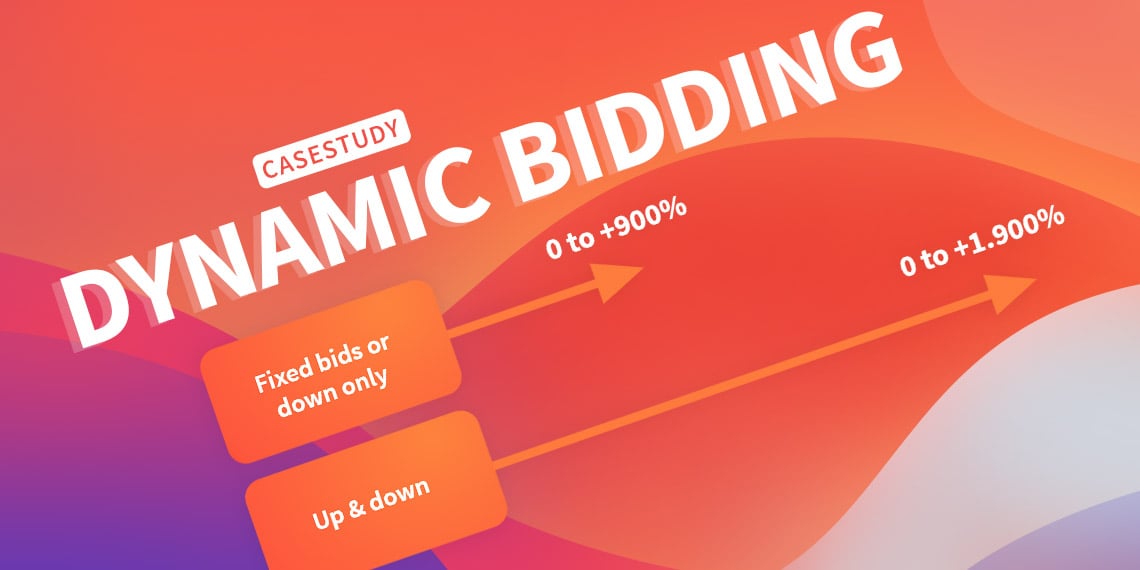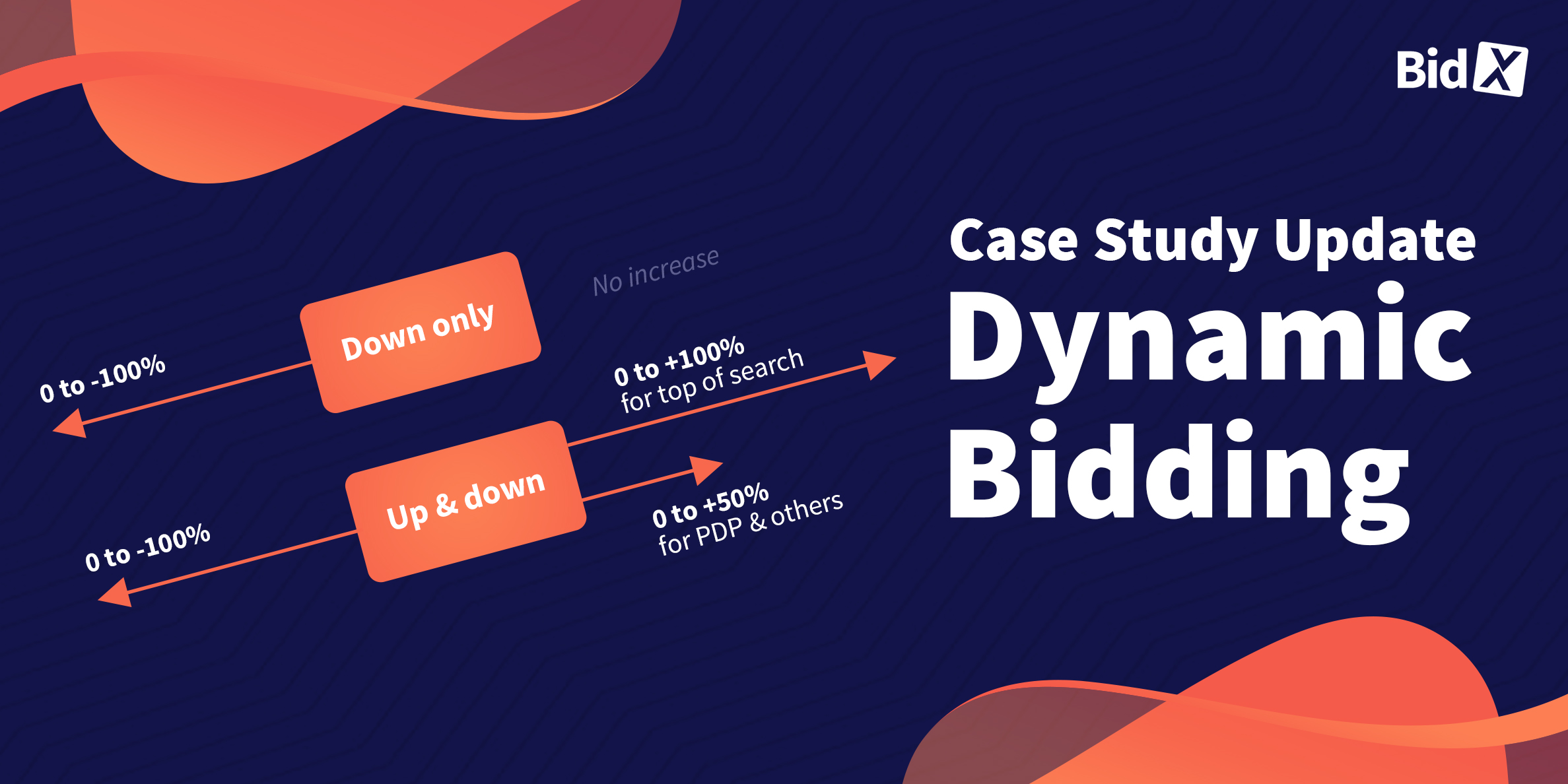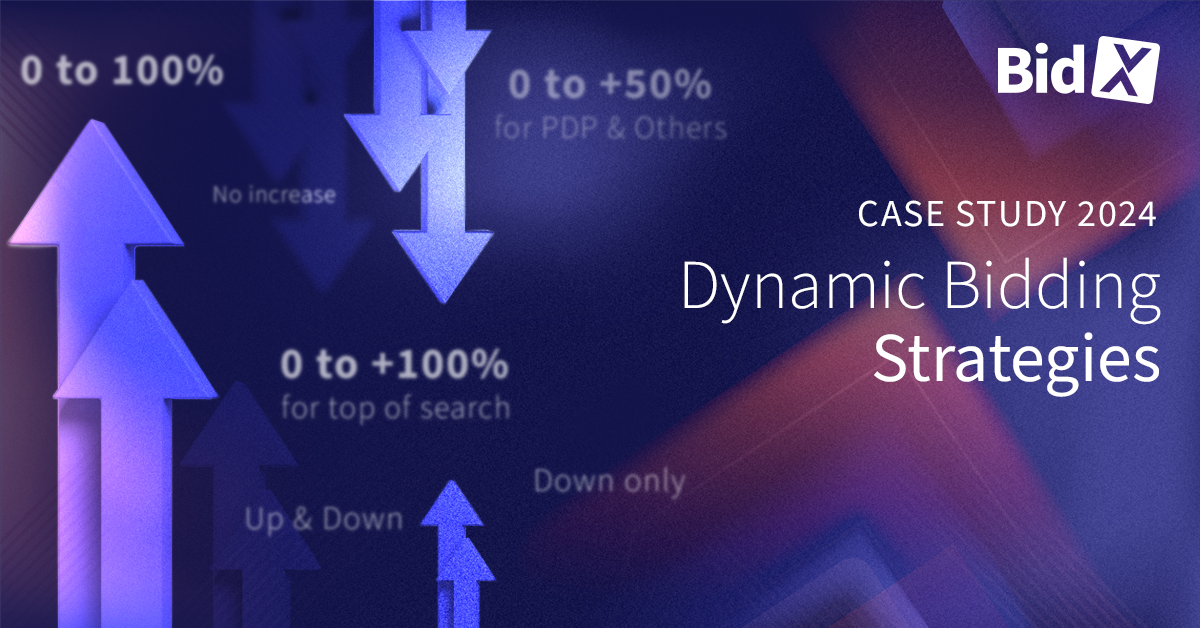Case study on Amazon dynamic bidding strategies and adjust bids by placement
Since the beginning of 2019, Amazon Advertising has three campaign bidding strategies for Sponsored Product Ads (SPA). In addition to fixed bids, there are two dynamic bidding strategies which can be selected in Seller Central. Bids can be increased or decreased depending on the customer's purchase probability. These are the strategies "Dynamic bids – down only" and "Dynamic bids – up and down". There is also the option "Adjust bids by placement", which replaces the former Bid+.
The following section explains what these strategies are all about before we present an analysis that compares the bidding strategies and bids by placement and their successes in practice. Based on these figures, we conclude by providing recommendations for Amazon sellers and the optimal use of dynamic bidding strategies.
You can also watch our video about dynamic bidding:
The article is structured as follows:
- Campaign bidding strategies
1.1 Fixed bids
1.2 Dynamic – down only
1.3 Dynamic – up and down - Adjust bids by placement
- Analysis of new functions
- Recommended To Dos for Amazon sellers
All bidding strategies apply at campaign level, i.e. the setting applies to all bids in the corresponding campaign. In the blog article "How to structure your Amazon PPC campaigns effectively?" we explain what the optimal campaign structure looks like.
1. Campaign bidding strategies
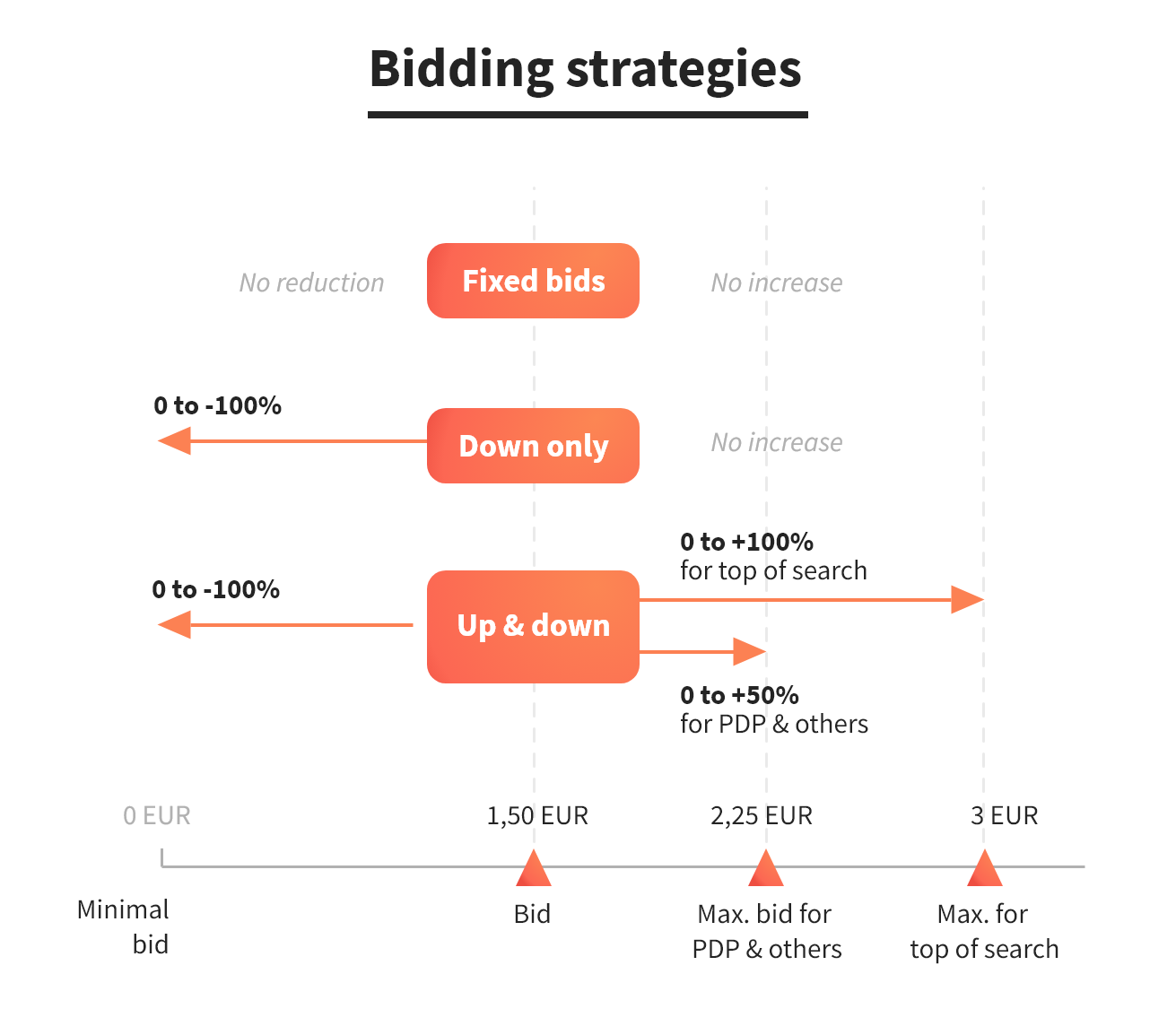
Overview of Amazons bidding strategies
1.1 Fixed bids
If you have selected the "Fixed Bids" strategy, Amazon will not adjust your bids, i.e. neither increase nor decrease them - even if there is a high purchase probability.
1.2 Dynamic bids - down only
Through the strategy "Dynamic bids – down only" your bids can be lowered by up to 100% - for clicks where it is unlikely that a subsequent purchase of the product takes place, i.e. a conversion is generated. This reduction of bids happens in real time.
Note: Campaigns created before 2019 will automatically use this type.
Example of "Down only":
You sell a bag, bid is 1.50 EUR for the keyword "handbag" and you have selected "Down only“. If a visitor enters this search term and Amazon assumes that a subsequent sale of your bag is unlikely, the bid for one click can be reduced to 0.40 EUR, for example. A reduction to 0,- EUR is also possible.
1.3 Dynamic bids – up and down
The strategy "Dynamic bids – up and down" leads to the fact that the bids - besides the possibility of the decrease (analogous to "Down only") with improbability of a sale - can also be increased, if a purchase is highly likely.
The maximum percentage by which bids are increased depends on the placement of the ads. For top of search placements, bids can be increased by max. 100% and for all other pages by max. 50%.
Example of "Up and down":
If you sell a bag and have selected 1.50 EUR for the keyword "handbag" and „up and down", the bid can be increased to 3.00 EUR for top of search placements - if Amazon determines a high purchase probability when entering this search term. For all other placements, the bid can be increased to a maximum of 2.25 EUR. If the probability of a sale is classified as low, the bid for one click can be reduced to up to 0.- EUR.
Amazon criteria
The criteria Amazon uses to determine the probability of a purchase are not disclosed by Amazon. Several factors play a role, such as the relevance of search terms, the expected click rate and the buying behaviour of the customer making the search query. But even this is not explained in detail by Amazon.
2. Adjust bids by placement
At this point we would like to briefly explain the possibility of "Adjust bids by placement". In addition to the bidding strategy, bids for clicks can also be increased depending on the placement. This is possible for top of search placements as well as for product detail pages. If advertisements compete for the corresponding placements, bids can be increased by up to 900%.
Note: This option can also be combined with dynamic bidding strategies. If "Adjust bids by placement" and "Dynamic bids - up and down" are activated, bids for top of search placements can be increased up to 20 times.
Example of "Up and down" and top of search placements:
If the standard bid is 1,50 EUR, it can be increased by 900% to 15,- EUR by "Adjust bids by placement". By "Dynamic bids – up and down“ these 15,- EUR can theoretically be increased again by 100% to 30,- EUR (+1.900%):
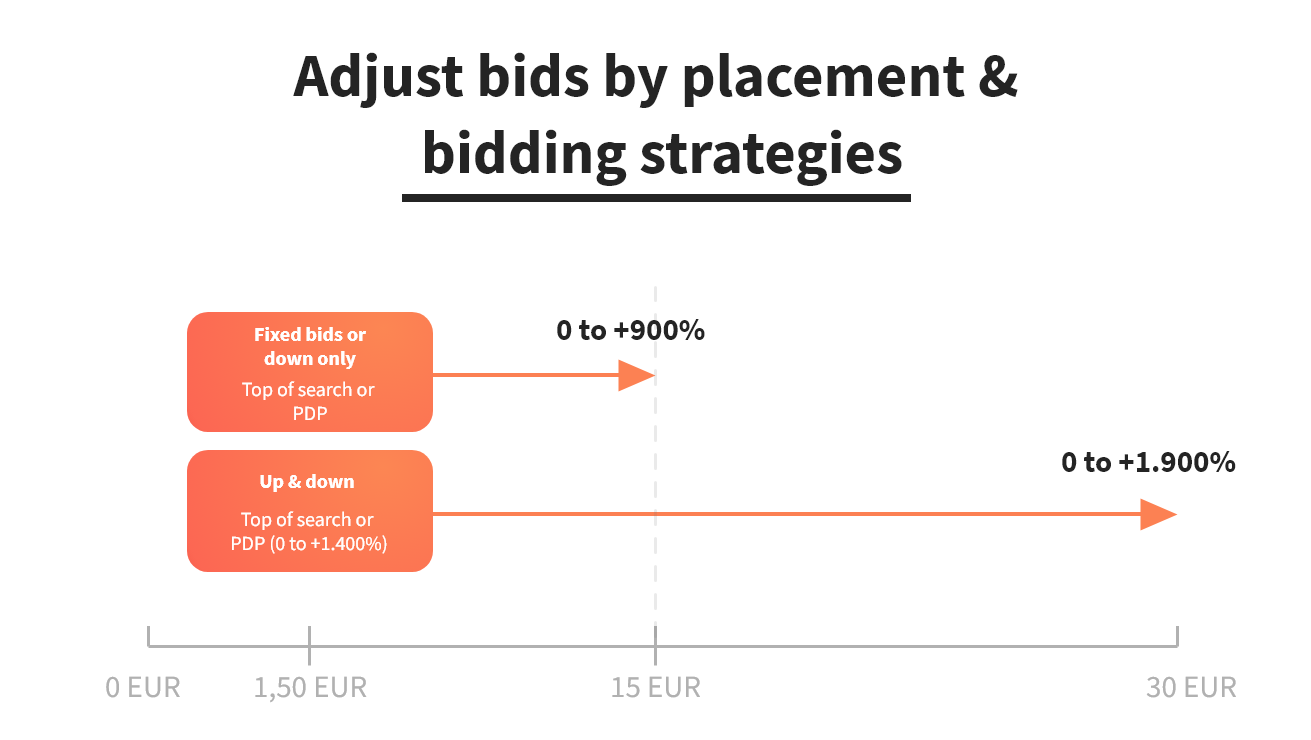
Example "Bidding strategies" and "Adjust bids by placement"
How do I find the best bidding strategy for my campaigns?
The best bidding strategy for your campaign depends on the advertised product, margin and competitive situation. Therefore, the performance of different bidding strategies should be compared.
Amazon itself recommends (Seller Central Login required) testing a campaign that has been running for some time, has a relatively stable ACoS and conversion rate, and is active with the "Dynamic bids – down only" strategy. This campaign should be set to "Dynamic bids – up and down" for a certain period of time. Due to the number of data and "more stable" key figures, changes can rather be traced back to the bidding strategy after the test - nevertheless no clear tracing back to the corresponding strategy can take place.
The bidding strategies can be changed at any time in the campaign settings. It is not advisable to create two identical campaigns with different bidding strategies, as this would make precise control much more difficult.
3. Analysis of the new functions
We analyzed and compared approximately 10,000 campaigns in the period from May to June 2019 with regard to their performance and the most important key figures when using "Dynamic bids – down only", "Dynamic bids – up and down" and "Fixed bids".
The results are shown in the following table:
Analysis of the effects of different bidding strategies
The best performance values of the individual key figures are highlighted in green. It can be seen that the campaigns with the strategy "Down only" on average have
- a better click rate,
- a lower cost per click as well as
- a lower ACoS
in our test. The conversion rate is the only key figure that shows a worse performance value with the strategy "Down only" than with the strategy "Up and down". By the difference of 1.12 percentage points it can be said that with the strategy "Up and down" it is about 10% more likely to generate a purchase than with the strategy "Down only". However, the ratio of advertising costs to sales achieved through advertising is 50% worse (see ACoS), i.e. the advertising costs spent are less profitable.
Since the "Down only" strategy has always achieved better results than "Up and down", we have examined the campaigns with the "Down only" bidding strategy for performance differences depending on the setting of the "Adjust bids by placement".
The results are shown in the following table:
Analysis of the effects of „Adjust bids by placement“
In this table, too, the best values of the four key figures are highlighted in green. If the increase of bids for "Top of search placements" was set to be greater than 0%, the values of
- the click rate
- and conversion rate
are highest. However, the average cost per click is 0.30€ higher than the 0% increase for top of search placements. The ACoS is also almost 4 percentage points higher. For placements on product detail pages, the following applies if the bid increase is above 0%:
- ACoS with an average of 32.15% as well as the
- the conversion rate of 7.41%
are worst. If the bid increase for placements on product detail pages has not been set, the ACoS is the best at 18.25%.
4. Recommended To Dos for Amazon sellers
Both for dynamic bids and for "Adjust bids by placement", the possibility of increasing bids in view of rising ACoS values is in principle not recommended.
Although the conversion rate in the "Up and down" bidding strategy is higher than in the "Down only" and "Fixed bids" strategy, the ACoS in this strategy is also more than 10 percentage points higher.
Which bidding strategy is best for you depends on your individual advertising goals.
If the focus of your advertising is on profitability, we recommend the strategy "Dynamic bids – down only" because of the lower ACoS.
The "Dynamic bids – up and down" strategy, on the other hand, is recommended for product launches where the focus is on product promotion rather than profitable ads.
We have visualized concrete recommendations in the following graphic and explained them in the following.

Recommendation bidding strategy
Bids for top of search placements
Due to better controllability of the ads we recommend for manual keyword campaigns to first halve the bid (from the original bid) and then increase it by approx. 104%.
In manual keyword campaigns, you will not receive any information in the keyword reports about which product detail pages you are displayed.
Example:
If the maximum CPC was originally 1 Euro, lower it to 0.50 EUR and then set the increase for bids top of search to 104%.
Thus you are with 1.02 EUR only minimally above your original maximum CPC. In addition, you outbid sellers who have chosen 100% or 1,- EUR as the typical round number.
Bids for placements on product detail pages
In manual campaigns with product attribute targeting (PAT), we recommend to quarters the bids first and then increase it to approx. 304% for placements on product detail pages. This has the background that the PAT ads also appear in the SERP, but no information about the search terms appears in the search term reports. The search term is the advertised ASIN itself.
Example:
If the maximum CPC was originally e.g. 1.- Euro, lower it to 0.25 EUR and then set the increase for bids on product detail pages to 304%.
Thus you are with 1.01 EUR only minimally above your original maximum CPC. In addition, as in the example above, you outbid sellers who have selected 300% or placed 1 EUR as a typical round bid.
Again to the background of these recommendations:
In the reports you do not get any information about which search terms and on which product detail pages you were displayed. This means that it is not possible to see which keywords you used to generate conversions. Therefore, no control according to performance data is possible and bid increases should be kept to a minimum due to profitability. Data such as the click rate can only be obtained through advertising. This data must be "bought" from Amazon. However, in this case you will not receive this information.
With regard to the dynamic bidding strategies, we recommend, as explained above, for a strategy aimed at profitability, to choose "Down only" - both for Auto and for Manual campaigns.
In addition, in Auto campaigns or PAT with category targeting, you should start with low bids due to the limited controllability and choose approx. ⅓ of the maximum cost per click.
Reminder: max. CPC = Target ACoS x Conversion Rate x Selling Price
The examples are summarized again in the following image with the corresponding amounts:

Example bid adjustements
If you have any questions about the presented bidding strategies, please feel free to contact us via hello@bidx.io
